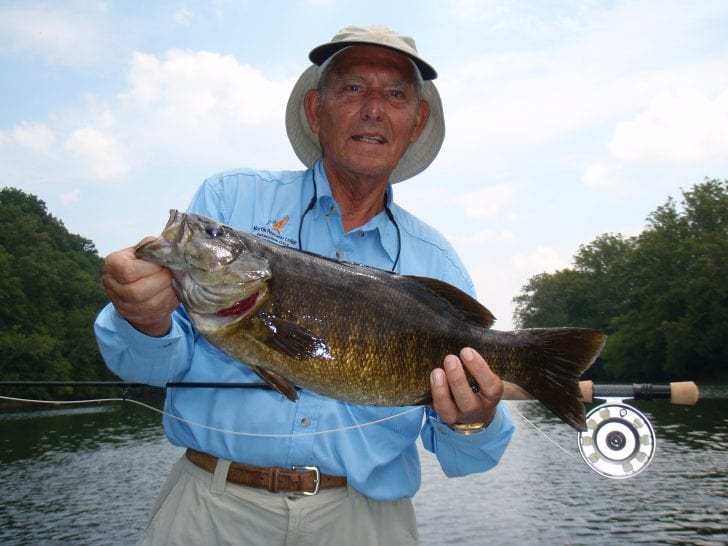By Britt Stoudenmire
Every year around the 4th of July, I begin to hear a “chirp” around 10a in the mornings. It starts very faintly, and over the course of the month it begins to increase in frequency and urgency. It is always exciting to hear this because it means the countdown to our “bug” season is on! I am sure some of you are wondering what in the world I am talking about and that is a good question. The “chirp” is the sound of the annual “dog day” cicadas as they emerge from the ground and climb amongst the trees to begin their reproductive cycle. Unlike the perennial cicadas that emerge every 17 years or so, the annual cicadas emerge every summer. At the end of the reproductive cycle, which typically begins by the first of August, they begin to die and fall into the river. If you are looking for big smallies, on the fly rod, and on top-water, August and September are the peak months and this is why.
Cicadas = Brownies
Over the years, I have given many seminars on bug fishing for smallies. The question I am most often asked is, “Why do smallies love cicadas so much?” and my response has always been quite humorous to the audience. “They are like brownies,” I always answer. Imagine you have just had the best spaghetti dinner of your life. You have eaten so much that your belly is about bust and now you are lying on the couch in a food-coma, catching the news. There is no way you are thinking about something to eat. You begin to notice a faint smell coming from the kitchen. Could it be warm brownies in the oven? A few minutes later you are presented with an option; should I eat this delicious smelling, warm brownie sundae or not? How many of you have the will-power to say no, no matter how full you feel? You simply can’t pass it up. Well, that is what a properly presented cicada is to smallmouth. They simply cannot pass it up, no matter how much they’ve been feeding. It makes for an awesome scenario and one that I look forward to every year!
Tip: While the big sycamore trees that line the banks of most rivers in the Blue Ridge Mountains are excellent choices to target for falling cicadas, don’t overlook mid-river habitat. Big smallies will come up for a cicada just about anywhere on the river if they see it.

Presenting a bug properly is they key to getting big smallies to eat versus them rejecting it. You will need to be able to cast 35 to 40-feet, with ease. The ability to double haul is certainly useful but not absolutely necessary. You want lift the bug off the water and cast it with no more than one false cast. You will then let the bug dead drift until the fly begins to drag. Sometimes this is just a few seconds, other times you may be able to get a drift for twenty seconds or more. But as soon as the fly begins to drag, you want to lift the bug and repeat the presentation. Some anglers like to let the bug drift until the ripple from the fly’s entry into the water dissipates. It is crucial not to pop the bug or the mend the bug during the drift because big smallies will reject it almost every time. Remember, this is a completely dead drift presentation just as a dead cicada would be drifting in the water.
Tip: Never give up on a fish that rejects your bug. Often he has rejected it because of draft on your fly. After he rejects and turns completely away from the bug, you can mend very slightly or pick the fly up every so gently and make a cast at least 10’ from the fish. Often they will turn around and make another move on it.
More…
There is so much I could write about bug fishing for big smallies in August and September that I simply don’t have the room here to do so. My biggest tip is to do some research and read different guides’ perspectives on the art of “bug” fishing. Then get out and practice your casting and even do some floats where you work on your presentations. Meanwhile, find a proficient guide in this craft and book a trip with him or her. That day or two on the water is invaluable to completing the process to becoming skilled at “bug” fishing.
Tip: “Bug” fishing is not a numbers bite. You are fishing for some of the biggest and wisest fish in the river, often times sight casting to them in very shallow and clear water. The encounters are simply riveting and the realistic shot at a 20” or bigger is there almost every outing.
The author, Britt Stoudenmire, and his wife Leigh, have been outfitting anglers for fifteen years on the New River in Virginia. They offer both guided fishing trips (newriveroutdoorco.com) and waterfront lodging (walkercreekretreat.com). 540-921-7438.
